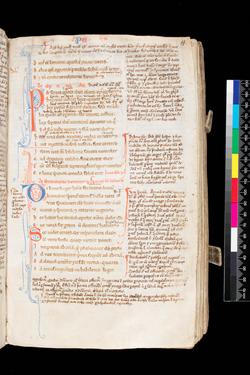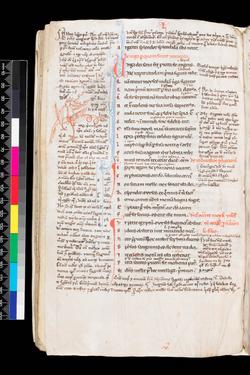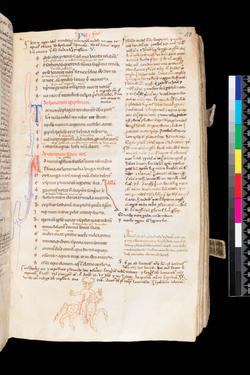Current Location: In storage
Titles
Aurora (Bible in verse)
Maker(s)
Bob Proctor (1990)
Author:
Riga, Peter
Entities
Categories
Description
PHYSICAL DESCRIPTION: Parchment, iii modern paper flyleaves + i parchment flyleaf from a thirteenth-century homiliary + 266 fols. + i parchment flyleaf from a thirteenth-century homiliary + iii modern paper flyleaves, 269 x 170 mm (200-220 x 140-150 mm, including gloss, for pages with 29 long lines of main text (fols. 1v-5r, 7r-118r, 142r-153r, 211r-260r), and 205-220 x 120-155 mm, including gloss, for pages with two columns of 40-43 lines (fols. 5v-6v, 118v-141v, 153v-210v, 260v-266v)), ruled in plummet and ink, written above top line, occasional running headers, quire marks, catchwords in quires with two-column layout only, magenta silk curtain sewn to protect initial on fol. 4r, sewing holes for protective curtains (now lost) and remains of thread in margins or upper frames of illuminated initials on fols. 7r, 76r, 88v, 97v, 103r, 142r, 211r
BINDING: 1990, white alum-tawed goatskin over contemporary oak boards, metal furniture from contemporary binding re-attached to modern goatskin and consisting of five brass bosses on each cover, two contemporary metal pins on upper cover, and two fragmentary leather straps attached with metal studs to lower cover, traces of paint on fore edge, rebound by Robert Proctor, alum-tawed skin covers from previous, late thirteenth- or fourteenth-century binding preserved together with an endband, a fragmentary support with sewing and binding fragments from the same thirteenth-century holimiary that provided the parchment flyleaves, number 63 written in red ink on upper cover
SECUNDO FOLIO: minoretur ut fieri
SCRIPT: Gothic bookhand (textualis)
CONTENTS
fol. 1r Aegidius of Paris, Poem on the authors of Aurora, beginning Scire cupis lector quis codicis istius auctor (ed. Beichner 1965, I, 11; Dinkova-Bruun 2012, 174), with miscellaneous verses and notes (James 1912a, 55-56) added in different hands (thirteenth-century additions)
fols. 1v-266v Peter Riga, Aurora with prose prologues, glosses and verses (ed. Beichner 1965), including substantial thirteenth-century additions by anonymous authors and Aegidius of Paris, and Geoffrey of Vinsauf, Poetria nova (fols. 209v-210v)
DECORATION
Three historiated initials in pale pink or blue with white patterns of palmettes, circles and geometric motifs within pink frames: fol. 7r General Prologue, [P, 7 ll.] Peter Riga writing at desk; fol. 103r Ruth, [A, 7 ll.] Bust of bearded man, probably Elimelech; fol. 211r Gospel of St Luke, [C, 8 ll.] King Herod enthroned, blessing and holding sceptre.
Six marginal drawings in red and brown ink illustrating adjacent main text or glosses: fol. 17v Two schematic representations of Noah’s Ark as arches supported by uprights; fol. 38v Winged two-legged serpent with a female head swallowing another (beside description of Moses’ brazen serpent); fol. 40r Demon on horseback (beneath typological interpretation of horses, demon and Satan in the Crossing of the Red Sea); fol. 240v Wise Virgin holding a lamp and an oil flask, accompanied by a lion passant (beneath passage on foolish and wise virgins); fol. 256r Stylised cross on a standard, with trilobe terminals and titulus Ie[su]s nazar[enus] rex iudeor[um].
Three marginal diagrams in brown ink embedded within glosses: fol. 51r T-map of the world and circular diagram of the firmament; fol. 77r Circular diagram of the mansions of the Twelve Tribes of Israel.
ORNAMENTATION
Six initials [5-8 ll.] in pale pink or blue, illuminated in the same style as the historiated initials, with white patterns of palmettes, circles and geometric motifs, within pink and/or green frames, filled with blue, pink or green vine scrolls terminating in orange leaves or dragon heads and occasional white blossoms on burnished gold grounds, for Lev, Num, Deut, Jos, Judges and I Kings (fols. 61v, 76r, 88v, 93r, 97v, 104v);
burnished gold initial [I, 26 ll.] in the form of a branch, with green, blue, red and pink lobes sprouting from its sides, within pale pink and blue frame, followed by burnished gold display capitals, [I]nitium, on a red and blue panel, for Prologue to Pentateuch (fol. 4r); zoomorphic initial [P, 8 ll.] formed of a biting dragon on burnished gold ground with green, red and blue vine-scroll infill and terminal, within blue frame, followed by burnished gold display capitals, [P]ost, on pink and green panels for Prologue to Gospels (fol. 142r); burnished gold initial [O, 4 ll.] filled with gold scrolls on blue and pink ground for General Prologue (fol. 1v);
red and blue parted initials [4-8 ll.] for select books in two distinct styles, one represented by three professionally executed initials (fols. 147r, 183r), the other containing numerous initials probably supplied by the scribes (e.g. fol. 123r); red penwork initial [P, 4 ll.] with arabesque motifs for the Six Days of Creation (fol. 7v); red penwork initial [P, 4 ll.] with brown pen flourishing for II Kings (fol. 114r); blue penwork initial [L, 7 ll.] with pink leafy terminals and red pen flourishing for Job (fol. 170v); red penwork initial [M, 6 ll.] filled with red foliate penwork for the Annunciation account in Luke (fol. 213r); red penwork initial [D, 6 ll.] with reserved designs, red foliate infill and brown ink circles for Acts (fol. 259v); alternate red and blue penwork initials [2-4 ll.] with blue or red pen-flourished motifs including spirals, knotwork and occasional faces, some referring to text (e.g. Adam’s bust on fol. 11r, De formatione homini), and paraph marks in the same style and colours, for minor divisions in the main text copied during the original campaign (e.g. fols. 8r, 11r, 88v); alternate red and blue penwork initials [2-3 ll.] with occasional pen flourishing or reserved ornament, and red penwork paraph marks, for minor divisions in the main text, executed by different hands during later campaigns (e.g. fols. 123r, 166v, 183r); occasional running headers in alternate red and blue one-line capitals; capitals highlighted in red.
Notes
History note: Purchased by Frank McClean (1837-1904) from Leo Olschki; his bequest, 1904.
Legal notes
Bequeathed by Frank McClean
Method of acquisition: Bequeathed
(1904)
by
McClean, Frank









